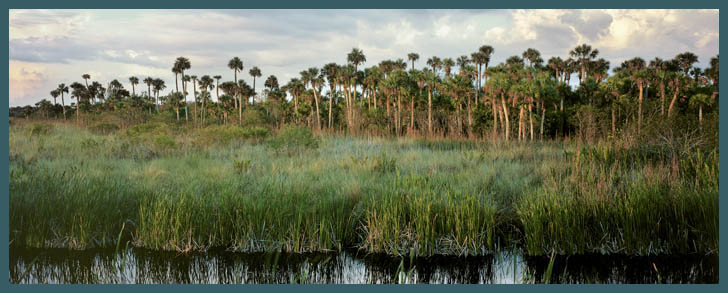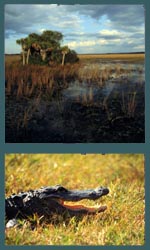by Kris W. Thoemke
Curiosity is perhaps the best way to describe the allure of Everglades National Park. It is a
unique part of our world and we are inherently attracted to that which is different.
Marjory Stoneman Douglas, grand matron of the Everglades immortalized the sprawling south
Florida wetland in her classic book, Everglades: River of Grass. "Nothing anywhere else is like
them," she wrote. "They are, they have always been, one of the unique regions of the earth,
remote, never wholly known."
What makes the park different is the easy-to-see wildlife, a collection of some familiar and some
unfamiliar species, that live in a one-of-a-kind setting. For the visitors that drive its roads, walk
its trails or float on its waters, Everglades National Park is a place of wonders like none most
have seen before.
While first time visitors continue to marvel at the park and its wildlife, those intimately familiar
with it know that what the tourists see, although fascinating and worthwhile, is not what evoked
the awe seen by the early naturalists who explored the region.
One hundred years ago, the land was home to hundreds of thousands of wading birds. The
daytime sky would turn black when flocks numbering 10,000 or more took to the air. Water, the
life blood of the Everglades, flowed through the River of Grass without interruption.
In his 1920 book, In Lower Florida Wilds, naturalist Charles Torry Simpson, wrote, "The greater
part of Lower Florida was an unbroken wilderness....when I first resided in the state (in 1882)
flamingos, roseate spoonbills, scarlet ibises and the beautiful plumed herons were abundant."
The Everglades were still untouched.
Seventy five years ago, Simpson concluded, "To-day most of its [south Florida's] hammocks are
destroyed, the streams are being dredged out and deepened, the Everglades are nearly drained;
even the pine forests are being cut down." Everglades watchers also noted, with increasing
frequency, the decline of the herons, egrets and ibis. The great swamp was in trouble.
The first efforts to preserve the Everglades as a national park came during Simpson's era. But
establishing this park was not an easy task. The movement to create it took almost 50 years and
several generations of supporters.
The first purchase-for-protection of Everglades land came in 1916. To prevent the trees on
Paradise Key, a hardwood hammock known for its plant diversity, from being cut down and
replaced with citrus, the Florida Federation of Women's Clubs purchased the land and gave it to
the state with the provision that it would become a state park.
A dozen years later, Ernest Coe began the first concentrated effort to set aside at least a million
acres for what he called the Tropical Everglades National Park. Arriving in Florida in 1928, Coe
formed the Tropical Everglades National Park Association and campaigned relentlessly for a
national park in the Everglades.
His goal ran into trouble when, in 1929, the Depression began and his plans stalled. Not to be
deterred, Coe persisted and finally convinced Congress to designate the Everglades as a national
park in 1934.
The struggle did not end when president Franklin D. Roosevelt signed legislation passed by the
Senate creating the park. It took park supporters another 13 years to get funding for the park. It
was not until 1947 that Everglades National Park officially opened its doors to the public.
The early supporters of the park, were they alive today, would probably be dismayed but not
surprised by the state of the Everglades. Even while they worked to preserve the grassy swamps,
mangrove forests and shallow bays, they knew of the problems likely to arise from the changes
taking place on the land outside the park's boundary.
Their fears became our realities and Everglades National Park is on the critical list today. At the
heart of the issue is water. Beginning in April of 1906, work began on the first project to drain
the Everglades. The goal was to change what was viewed as a worthless swamp into land for
housing and agricultural purposes. Ninety years later the system is still in place and in need of
constant attention.
To make the Everglades "useful," the US Army Corps of Engineers and state government
officials authorized the digging of miles of canals, creating impoundments to store water, and
installing structures designed to regulate the flow of water within the world's largest outdoor
plumbing system.
Although never considered a complete success in terms of converting all the wetlands into
developable lands, the project was highly effective in turning off the flow of fresh water to the
park. This act is seen as the major reason for the decline of wildlife in the park. And until
recently, all attempts to reverse this pattern and supply the park with fresh water have been
unsuccessful.
If we had to close the book on the history of the park tomorrow, we would have to record its
decline as one of man's colossal mistakes. Fortunately, history never ends and we have a chance,
some day in the future, to add the results of our forthcoming actions.
Over the past five years, conservation groups, agribusinesses, and government agencies
negotiated to get a plan adopted that would restore Everglades National Park. The cornerstone of
the project is redirecting some of the water diverted from the River of Grass. Those wanting to
see more water flow into the park can rightfully claim victory.
No one now disputes that the park is in trouble, water is the key to the problem, and that
everyone must help solve the problem. The last looming question to be resolved is deciding how
to divide the bill between the groups that agreed to pay for the project.
The resolution of that question is the next page in the Everglade's history book.


